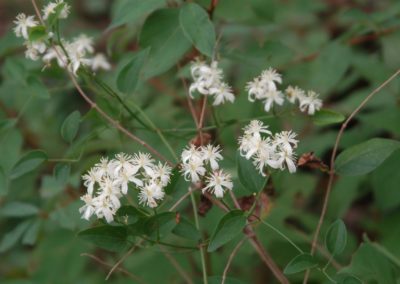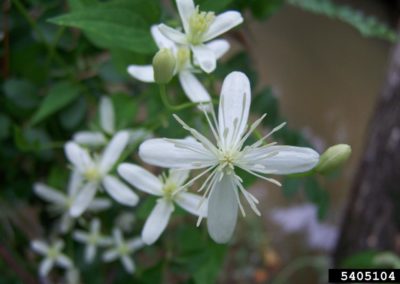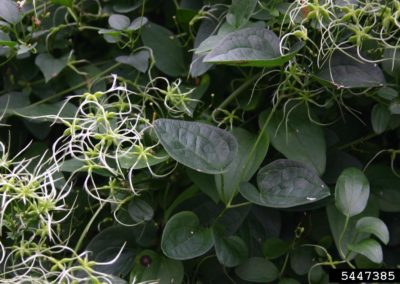Sweet Autumn Clematis (Clematis terniflora)
Invasive Management Profile
Sweet Autumn Clematis has become an invasive species in Indiana due to its similarities to the native species, Clematis virginiana. This may cause difficulty with the identification between the Asian and native variety.
Identification
The Sweet Autumn Clematis has smooth edges on its leaves. As its name suggests, the Sweet Autumn Clematis blooms in late summer and fall. The plant blooms with fragent small, white, star shaped flowers. The flowers cover most of the plant when it is in full bloom.Because there is a native species of Clematis, make sure you properly identify. The native Clematis know as Virgin’s Bower has coarsely toothed, trifolate leaves while the invasive Sweet Autumn Clematis has smooth or, occasionally, single-lobed leaves. Make sure you read the labels of seeds and plants you are purchasing.
Tools & Supplies Needed
- Herbicide
- Protective clothing, gloves, and eyewear
- Shovel or spade
Removal Methods
Sweet Autumn Clematis is fairly easy to remove depending on the size of the bush. Use pulling method for small plants.
STEP 1 : Identify plant using our identification tips and photos as well as the time of year and growth stage.
STEP 2 : Wear protective eyewear, gloves, and clothing.
STEP 3 : Use your hand to grab the bottom of the plant, twist, and pull.
STEP 4 : When pulling, make sure to remove the taproot, which is the main root system (this may be easily removed with a spade or shovel as well).
STEP 5 : Make sure to place all plant debris into a plastic or paper bag to control seed spread.
If you have a full grown Sweet Autumn Clematis, try the cutting method.
STEP 1 : Identify plant using our identification tips and photos as well as the time of year and growth stage.
STEP 2 : Wear protective eyewear, gloves and clothing.
STEP 3 : Using a handsaw to cut the vine 5-10 inches from the ground. Be aware of your surroundings and always wear protection when using this equipment.
STEP 4 : Treat with herbicide or remove root system. For removal of the root system, start digging 3 feet away from the base of the stump. Click here to learn more about herbicide use.
STEP 6 : Once you can see the majority of the rootball, slide your shovel under it and gently begin loosening and prying it up, away from the ground.
STEP 7 : Once the rootball is free place it and all clippings on a tarp to stop the spreading of seeds or regrowth.
Disposal
For disposal of Sweet Autumn Clematis, package the plant waste in a large plastic or paper bag for landfill.
Native Alternative Species
To learn more about natives and how to landscape with them click here.
Virgin’s bower (Clematis virginiana)
Photo Courtesy of INPAWS
Virginia creeper (Parthenocissus quinquefolia)
Photo Courtesy of INPAWS




